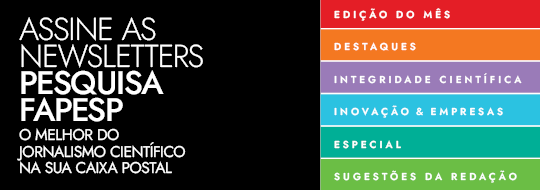Ethanol is becoming an increasingly endearing topic to Pesquisa FAPESP, making excellent cover stories. This time, the reason why the cover story is on ethanol is the latest and well-supported view of how sugar cane bagasse, an abundant by-product of Brazil’s sugar cane industry, can provide our country with a strong competitive edge in the international race for second-generation ethanol. Fabrício Marques, our scientific and technology editor, highlights this possibility in a well-written article on the pioneer networking of different research groups which, encouraged by consistent institutional policies, have focused courageously on studies that search for new ways and methods to extract ethanol from plant cellulose. Sugar cane bagasse and trash, sources of cellulose, account for two thirds of the energy from sugar cane that is not converted into biofuel. Not yet.
The cover story is further enriched by the ping-pong interview with Lee Lynd, a pioneer in the field of research on the use of biomass to produce energy. Among other achievements, the group headed by this U.S. researcher has developed a consolidated bioprocessing technique/CBP. This technique reduces the four standard stages that most biological routes avail themselves of to process biomass cellulose to a single phase. This undoubtedly represents a similar and potentially less expensive way of obtaining second-generation ethanol. Lynd, who is going to participate in a Bioen workshop organized by Fapesp in early September, believes that cellulose ethanol and sugar cane ethanol will, in the near future, complement each other rather than compete with each other.
I would also like to highlight in this issue the opening text of the science section. In other circumstances, the topic would undoubtedly have been the cover story. Prepared by assistant editor Maria Guimarães, the article explains in detail how the identification of a series of proteins involved in the biochemical mechanisms of schizophrenia and a better understanding of the ways in which the illness is expressed ultimately provide solid support for the idea that some of the related symptoms can be caused by degeneration of the nervous system. This degeneration might be worsened by the existence of excess calcium in the neurons of specific parts of the brain. In other words, the physical basis of the illness is thus reinforced.
I will very briefly mention the other highlights in this issue, given the need to conciliate lack of space with a variety of information. I will begin with the opening article in the technology section: editor Marcos de Oliveira explains very clearly and in detail what the optic fiber cable with internet transmission capacity of 10 gigabytes per second will be used for. This is now available to São Paulo’s academic community and was inaugurated on July 31 with transmission to the United States and Japan of the first high-definition feature film produced in Brazil. The opening text of the humanities section is by editor Carlos Haag; it is based on a study of consumption in São Paulo in the period from 1890 to 1915, and shows the recent relationships that historians have established between social behavior of buying and the specific features of Brazilian capitalism.
I go back to the first pages to highlight the lively interview with one of the most renowned contemporary experts on communication, Jesús Martín-Barbero. Voicing new and provocative views on communication and culture, alerting us to the intermediary period we are living in nowadays, revolutionized by the Internet and without any kind of clue as to what kind of world we are creating, this expert, who is nearly 72 years old, fascinated an audience of more than 800 predominantly young people at the Memorial da América Latina center on the afternoon of August 17. Finally, I recommend the text written by editor-in-chief Neldson Marcolin, at the end of the science section, on page 56. He writes about Carlos Chagas, the renowned Brazilian physician who 100 years ago discovered the full cycle of Chagas Disease. This article is accompanied by another text, which explains the reason for a cocktail of medical drugs against the Trypanosoma cruzi, which causes the disease.
Republish